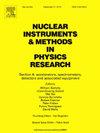DDFRG3:高能核碰撞中子产生的双差分 FRaGmentation 模型
IF 1.5
3区 物理与天体物理
Q3 INSTRUMENTS & INSTRUMENTATION
Nuclear Instruments & Methods in Physics Research Section A-accelerators Spectrometers Detectors and Associated Equipment
Pub Date : 2024-11-14
DOI:10.1016/j.nima.2024.170056
引用次数: 0
摘要
为空间辐射应用开发了一种用于核-核碰撞产生中子的双差分中子生成(DDFRG)模型。DDFRG1 是以前为质子和轻离子产生而开发的模型,DDFRG2 是为先驱子产生而开发的模型。本研究开发了一个用于中子产生的新模型(DDFRG3),该模型基于射弹、靶和中心火球源的中子热产生。洛伦兹不变双差分截面是在各种源框架下计算的,并经过洛伦兹变换到实验室框架,从而得到一个闭式解析公式,无需进行数值积分,可以在辐射传输代码中非常高效地运行。然后对洛伦兹不变的双差分截面进行角度积分,得出单差分能谱分布。DDFRG3 中子模型与广泛的实验数据集相比效果非常好。本文章由计算机程序翻译,如有差异,请以英文原文为准。
DDFRG3: Double-Differential FRaGmentation model for Neutron production in high energy nuclear collisions
A Double-Differential FRaGmentation (DDFRG) model for neutron production from nucleus–nucleus collisions is developed for space radiation applications. DDFRG1 was a previous model developed for production of protons and light ions, and DDFRG2 was a model developed for pion production. A new model (DDFRG3) for neutron production is developed in the present work, and is based upon thermal production of neutrons from the projectile, the target and central fireball sources. The Lorentz-invariant double-differential cross sections are calculated in the various source frames, and are Lorentz transformed to the laboratory frame, resulting in a closed-form analytic formula involving no numerical integration, and which can be run very efficiently in radiation transport codes. The Lorentz-invariant double-differential cross section is then integrated over angle to give the single-differential energy spectral distribution. The DDFRG3 neutron model compares very well to an extensive experimental data set.
求助全文
通过发布文献求助,成功后即可免费获取论文全文。
去求助
来源期刊
CiteScore
3.20
自引率
21.40%
发文量
787
审稿时长
1 months
期刊介绍:
Section A of Nuclear Instruments and Methods in Physics Research publishes papers on design, manufacturing and performance of scientific instruments with an emphasis on large scale facilities. This includes the development of particle accelerators, ion sources, beam transport systems and target arrangements as well as the use of secondary phenomena such as synchrotron radiation and free electron lasers. It also includes all types of instrumentation for the detection and spectrometry of radiations from high energy processes and nuclear decays, as well as instrumentation for experiments at nuclear reactors. Specialized electronics for nuclear and other types of spectrometry as well as computerization of measurements and control systems in this area also find their place in the A section.
Theoretical as well as experimental papers are accepted.

 求助内容:
求助内容: 应助结果提醒方式:
应助结果提醒方式:


